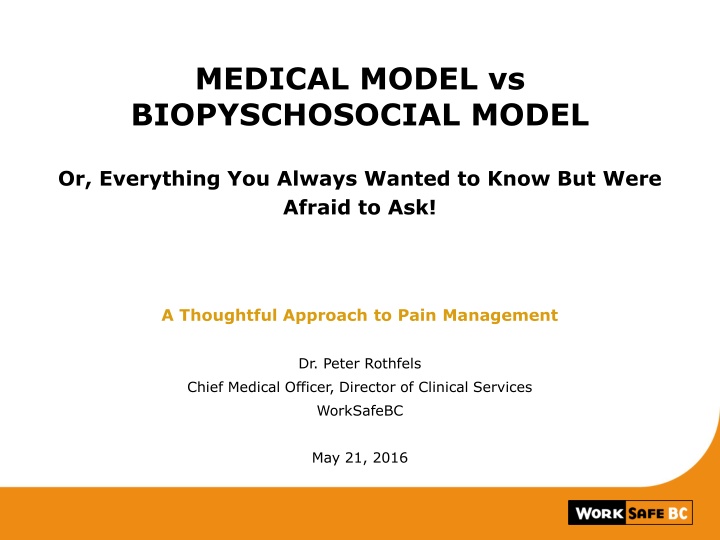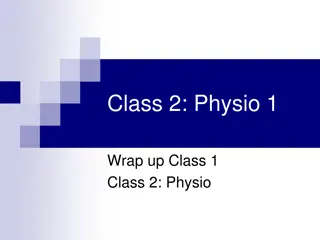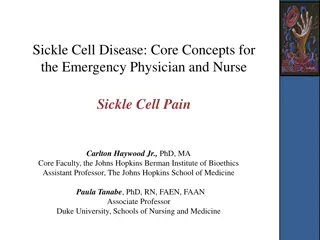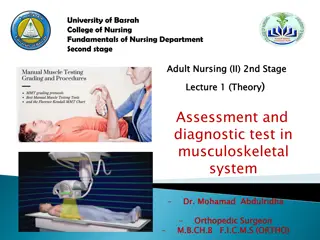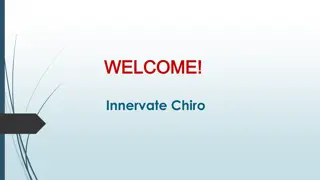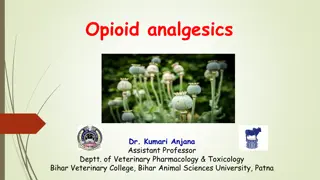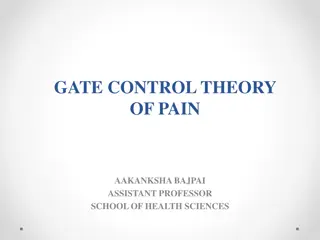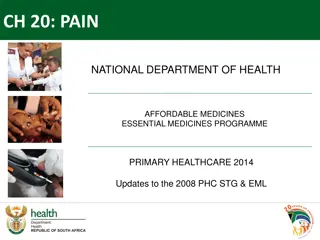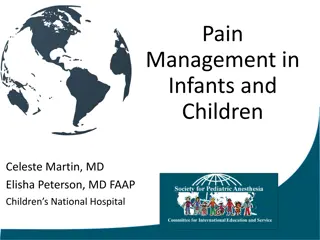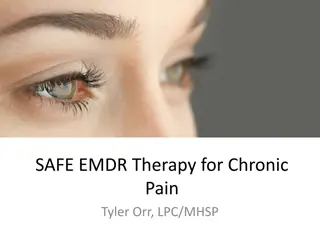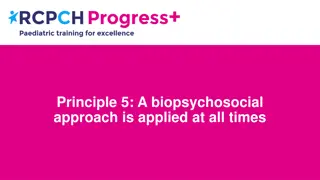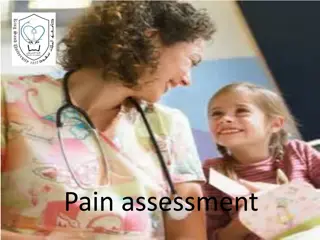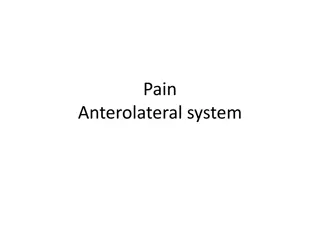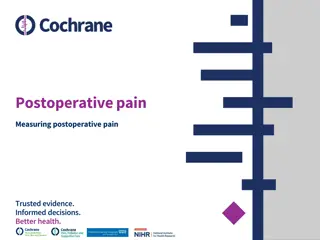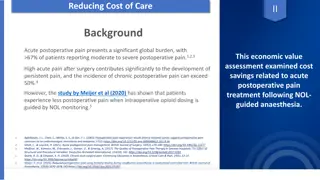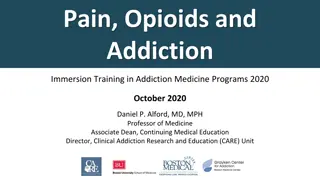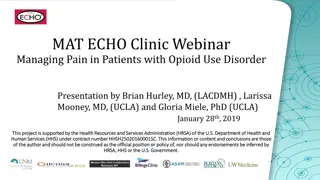Pain Management Approaches: Medical vs. Biopsychosocial Models
This presentation by Dr. Peter Rothfels explores the differences between the Medical Model and the Biopsychosocial Model in pain management. Through a case study, various stages of care and interventions are discussed, highlighting how each model influences treatment decisions.
Download Presentation

Please find below an Image/Link to download the presentation.
The content on the website is provided AS IS for your information and personal use only. It may not be sold, licensed, or shared on other websites without obtaining consent from the author.If you encounter any issues during the download, it is possible that the publisher has removed the file from their server.
You are allowed to download the files provided on this website for personal or commercial use, subject to the condition that they are used lawfully. All files are the property of their respective owners.
The content on the website is provided AS IS for your information and personal use only. It may not be sold, licensed, or shared on other websites without obtaining consent from the author.
E N D
Presentation Transcript
MEDICAL MODEL vs BIOPYSCHOSOCIAL MODEL Or, Everything You Always Wanted to Know But Were Afraid to Ask! A Thoughtful Approach to Pain Management Dr. Peter Rothfels Chief Medical Officer, Director of Clinical Services WorkSafeBC May 21, 2016
DISCLOSURE My salary is paid by WorkSafeBC No conflict of interest I have lots of opinions 2
OBJECTIVES By the end of this presentation, the attendees will 1. Understand what is meant by the Medical Model 2. Understand the basic concepts of the Biopsychosocial Model 3
OBJECTIVE #1 MEDICAL MODEL 4
CASE STUDY Typical: 48 year-old male, 5 10 , 210 lbs. injures dominant right shoulder while lifting 15 lb. block. No prior right shoulder history, a few STI s (work related) in past 15 years. Smokes ppd, single,2 teenage children. Diagnosis: Plan: F/U: Right shoulder strain. Conservative. NSAIDS. 2 weeks. 5
2 WEEKS Increased pain, decreased ROM, complaining of loss of strength PLAN: X-ray, PT, Tylenol #3 added. 6
4 WEEKS X-rays show early degenerative AC joint Patient has increasing pain, decreased ROM, now pain radiating to neck PLAN: X-ray c-spine, continue PT, Tylenol #3 refilled 7
6 WEEKS X-rays show mild degenerative cervical disc disease Patient presents with right shoulder and neck pain can t do anything at home , angry, not sleeping, stress PLAN: Oxycodone prescribed for pain, Lorazepam for stress, refer Ortho 8
8-10 WEEKS MRI arranged, shows rotator cuff tendonopathy, no tear, labrum normal Oxycodone and Lorazepam refilled, Z drug to help him sleep 9
12 WEEKS Ortho assessment, subacromial impingement, early degenerative changes PLAN: Steroid Injection 10
14 WEEKS F/U with GP: PAIN! PAIN! PAIN! Injection not helpful, DEPRESSED! Increased neck pain, stiffness, paresthesias to fingers Assessment: Thoracic Outlet Syndrome PLAN: Refer neurology and MRI of thoracic outlets. SSRI antidepressant added. 11
16 WEEKS PAIN! PAIN! PAIN! Waiting for Neuro Oxycodone no longer helping, MS Contin 20mgs bid prescribed PLAN: 2nd Steroid Injection 12
18 WEEKS MRI Thoracic Outlets normal Neurology normal, aside from mild bilateral median nerve neuropathy PLAN: Refill all medications 13
20 WEEKS PAIN! PAIN! PAIN! Can t do anything at home Depressed Angry MS-Contin 20 mgs not strong enough Wants 2nd Ortho opinion PLAN: MS-Contin 40 mgs bid prescribed with MSIR for breakthrough 14
22 WEEKS Second orthopedic assessment Agrees with first opinion, no rotator cuff pathology, surgery unlikely to help including a subacromial decompression 15
24 WEEKS PAIN! PAIN! PAIN! Depression GP now recommends physiatrist consult and prescribes Hydromorphone, as well as Lorazepam, SSRI, and Z 16
26 WEEKS Specialist Diagnosis: Cervico-Scapular- Thoracic Myofascial Pain Syndrome Recommends: Botox, Gabapentin, Amitriptyline 17
28-52 WEEKS PAIN! PAIN! PAIN! Depressed Angry Diagnoses including CRPS, Fibromyalgia, etc. Chronic Pain Program: not helpful Patient has not returned to work, very depressed, socially isolated, etc. 18
Medical Model Injury Pain Pathology of bone, muscle or peripheral nerve Pills (opioid) deficiency Treatment A little, more, a lot more, way way more Resolution Discharge Send to Psychiatry 20
Medical Model P Paradigm: Prescribe Pills Palliate Pain Perform Procedures Please Patient 21
The first duty of the physician is to educate the masses to not take medicine. Sir William Osler (1849-1919) 22
OBJECTIVE #2 BIOPSYCHOSOCIAL MODEL 23
Reduced activity PHYSICAL DETERIORATION Depression Helplessness Frustration Anger Poor Sleep Central Sensitization Unhelpful beliefs and thoughts CHRONIC PAIN Repeated treatments, medications and failures INJURY Tissue damage (nociceptive) Long term use of analgesics/sedatives Side Effects Lethargy Fatigue Constipation Loss of job, financial, family and stress Excessive suffering and disability 24
Biopsychosocial Model Focus on Individual Focus on Function (Activity/Movement) A. B. C. Health related factors Personal factors Environmental factors 25
Biopsychosocial Model ~ Pain & Disability A. Health Related Factors Health care providers attitude, knowledge and expectations Severity of anxiety or depressive symptoms Duration of disability Co-morbidities (other physical and psychological conditions) Substance abuse disorder 26
Biopsychosocial Model ~ Pain & Disability B. Personal Factors Socioeconomic status Patient s understanding of condition and expectations Catastrophization heightened pain expression Coping style avoidant, passive, dependent Disability belief fear of re-injury Pain belief pain means something is seriously wrong Perceived injustice work, home, life ACE (adverse childhood event) Job dissatisfaction, negative feelings toward work, supervisor, co-workers 27
Biopsychosocial Model ~ Pain & Disability C. Environmental Factors Personal relationships, social network Unmarried, poor relationship situation Lack of family, friends, and/or community support Social isolation at home Stressful life events Secondary gain insurance, WCB, family, etc. 28
Biopsychosocial Model Pain score how helpful is this? Ask: How much does your pain bother you? Pain bothersomeness? In what way? How is your pain affecting your life? 29
Pain vs Suffering Listen to their words Many patients have been told by several past providers You have to learn to live with it But How?? 30
Discussion Points Explain pain Including central sensitization (in lay terms) Hurt vs Harm Ask about their expectations What are their functional goals? Talk about other modalities, activation Set very achievable and realistic short term goals 31
Modalities/Techniques Ways to Decrease Pain Intensity 1. CBT Cognitive Behavioural Therapy 2. DBT Dialectical Behaviour Therapy 3. ACT Acceptance and Commitment Therapy 4. Attention/Distraction 5. Mindfulness 6. Yoga 7. Activity (don t call it exercise) 8. Contingency Management using incentives to motivate change 32
Its Not Magic or Fluffy Specific or non-specific pain central sensitization Rational evidence based treatments Opioids are rarely beneficial benefit vs risk Listen Be empathetic Schedule another appointment more time 33
Therapeutic Alliance Patient Doctor fear anger anxiety guilt Shame loss honesty compassion understanding tact thick skin sense of humour knowledgeable empathy fear of abandonment frustration resentment hopelessness food, housing, transportation criminal justice system 34
What can we give our patients? Particularly those with long term chronic pain conditions months to years of medicalization months to years of specialists, multiple investigations, surgeries months to years of cocktails of medications, usually including (high dose) opioids We can also 35
Give our patients Therapeutic Optimism HOPE 36
In theory, there is no difference between theory and practice; in practice, there is. Dean Fixsen 37
THANK YOU! QUESTIONS? 38
